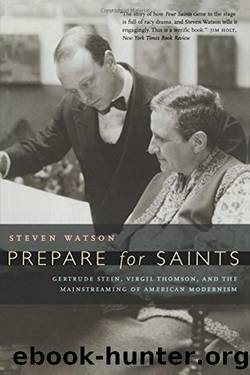Prepare for Saints: Gertrude Stein, Virgil Thomson, and the Mainstreaming of American Modernism by Steven Watson

Author:Steven Watson [Watson, Steven]
Language: eng
Format: epub
Tags: 20th Century, History, Modern, Music, Non-Fiction, Opera, Social History
ISBN: 9780307822734
Google: 5uhBlPoKnCMC
Amazon: 0520223535
Publisher: Random House Publishing Group
Published: 2012-09-04T23:00:00+00:00
CHAPTER 11
Modernism Goes Uptown
In early 1933, Virgil Thomson traveled up to Harlem with Henry-Russell Hitchcock. Four years earlier, following Four Saints’ first performance in the United States at Carl Van Vechten’s, he had been introduced to Harlem in its pre-Crash heyday. Although Harlem’s determined hedonism had diminished by the time of Thomson’s second visit, it was still swinging. Guests at the Askews’ often took their party uptown, a night at the theater was frequently capped with dancing in Harlem, a difficult day might be unburdened by the speakeasy gin or marijuana “reefers” available on 133rd Street. “To us,” Lincoln Kirstein recalled, “Harlem was far more an arrondisement of Paris than a battleground of Greater New York.”1 Some took the A train, which offered a cheap subterranean journey. Others taxied through Central Park, their yellow cabs emerging from the foliage into a region where skin colors were darker and spirits seemed unfailingly brighter—at least in the glow of nightclub lighting and speakeasy inebriation that most white visitors knew. “Harlem is the one place that is gay and delightful however dull and depressing the downtown regions may be,” wrote one uptown visitor to his midwestern parents. “Nothing affects the vitality and the freshness of Harlem.”2
By the mid-1920s, Harlem had replaced Greenwich Village as the mecca of writers, performers, artists, bohemians, and the cosmopolitan chic. They flocked to “Jungle Alley”—133rd Street between Lenox and Fifth Avenues—to such recently opened nightclubs as the Cotton Club and Connie’s Inn, which thrived by catering exclusively to a white clientele. By the end of the 1920s, even those who could not travel to Harlem could picture it. They read about it in magazine articles and gossip columns or in Carl Van Vechten’s controversial best-selling novel Nigger Heaven. They played gramophone recordings of black vocalists and listened to the Cotton Club Orchestra on the radio. Harlemania attracted tourists from across the United States and visitors from Europe who were eager to mingle with—or at least witness—the exotic world they had constructed in their imaginations.
Color lines blurred, but a glimpse of a Cotton Club performance reveals the still carefully prescribed rules. The audience consisted of expensively dressed white couples eating overpriced Continental food and taking generous swigs from nickel-plated liquor flasks they carried in their pockets. Onstage were black performers and a scantily clad chorus line of women who were “tall, tan, and terrific” (hiring rules stipulated that performers be under twenty-one years of age; over five feet, six inches in height; and “high yaller” in complexion). The distance between audience and performer was no more than a few feet, but the separation between the paying and the paid, the dressed and the nearly undressed, remained total.
But such a snapshot is incomplete, for whites and blacks mixed in other places, sometimes only a few doors down from the lavish whites-only nightclubs. “Harlem is a magic melting pot,” observed Harlem Renaissance novelist Wallace Thurman, “a modern Babel mocking the gods with its cosmopolitan uniqueness.”3 Harlem’s attractions included the dancing, tray-twirling waiters at the mixed-race nightclub Small’s Paradise.
Download
This site does not store any files on its server. We only index and link to content provided by other sites. Please contact the content providers to delete copyright contents if any and email us, we'll remove relevant links or contents immediately.
The Goal (Off-Campus #4) by Elle Kennedy(13542)
Kathy Andrews Collection by Kathy Andrews(11726)
Diary of a Player by Brad Paisley(7487)
What Does This Button Do? by Bruce Dickinson(6133)
Assassin’s Fate by Robin Hobb(6126)
Big Little Lies by Liane Moriarty(5699)
Altered Sensations by David Pantalony(5043)
Pale Blue Dot by Carl Sagan(4907)
Sticky Fingers by Joe Hagan(4100)
The Death of the Heart by Elizabeth Bowen(3551)
The Heroin Diaries by Nikki Sixx(3492)
Beneath These Shadows by Meghan March(3261)
Confessions of a Video Vixen by Karrine Steffans(3240)
How Music Works by David Byrne(3184)
The Help by Kathryn Stockett(3082)
Jam by Jam (epub)(3020)
Harry Potter 4 - Harry Potter and The Goblet of Fire by J.K.Rowling(2984)
Strange Fascination: David Bowie: The Definitive Story by David Buckley(2797)
Petty: The Biography by Warren Zanes(2697)
